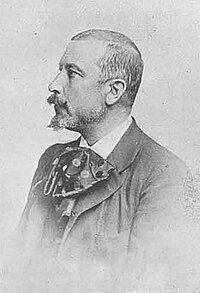José Malhoa
José Malhoa | |
|---|---|
 | |
| Born | José Vital Branco Malhoa 28 April 1855 |
| Died | 26 October 1933 (aged 78) |
| Nationality | Portuguese |
| Known for | Painting |
| Notable work | The Drunks, 1907, Fado, 1910, Autumn, 1918 |
| Movement | Naturalism |
José Vital Branco Malhoa, known simply as José Malhoa (28 April 1855 - 26 October 1933) was a Portuguese painter.
Biography
[edit]Malhoa was, with Columbano Bordalo Pinheiro, the leading name in Portuguese naturalist painting in the second half of the 19th century.[1] He often painted popular scenes and subjects, like his two most famous paintings: The Drunks (1907) and Fado (1910). He always remained faithful to the naturalist style, but in some of his works there are impressionist influences, as in his Autumn (1918), that can be considered an "impressionist exercise".
Malhoa was born in Caldas da Rainha, and studied art at the Royal Academy of Fine Arts in Lisbon from the age of 12. He died in Figueiró dos Vinhos, aged 78. At the end of his life, he saw the inauguration of the José Malhoa Museum, in Caldas da Rainha.
Malhoa's House, also known as the Dr. Anastácio-Gonçalves House-Museum, in Lisbon, was originally built in 1905 as a residence and studio for the artist. It was bought by Dr. Anastácio-Gonçalves, an art collector, a year before the painter's death, and it became a museum in 1980, showcasing several items from his collection, namely works from Portuguese painters of the 19th and 20th century.[2]
From 1921 until his death he was the master of the renowned painter Maria de Lourdes de Mello e Castro, who was his last disciple.
In 1933, the year of his death, the José Malhoa Museum was created in Caldas da Rainha. He had artistic collaboration in the magazine Atlântida'.'[3] (1915-1920). His well known studio, named "Casulo", in Figueiró dos Vinhos, is restored and available for visits.
He was buried in the Prazeres Cemetery, in Lisbon.
References
[edit]- ^ António Costa Pinto (1998). Modern Portugal. Society for the Promotion of Science and Scholarship. p. 245. ISBN 978-0-930664-17-6.
- ^ "Igespar Ip | Heritage". Igespar.pt. 1982-02-26. Archived from the original on 2012-08-03. Retrieved 2012-02-07.
- ^ Rita Correia (19 February 2008). "Ficha histórica: Atlantida: mensário artístico, literário e social para Portugal e Brasil" (PDF). Hemeroteca Municipal de Lisboa. Retrieved 17 June 2014.

Literature
[edit]- Henriques, P.: José Malhoa; INAPA, Lisbon, 1996. ISBN 972-9019-87-8
External links
[edit]- Biography and Works[permanent dead link], in Portuguese.
- José Malhoa - artworks at Google Arts & Culture
